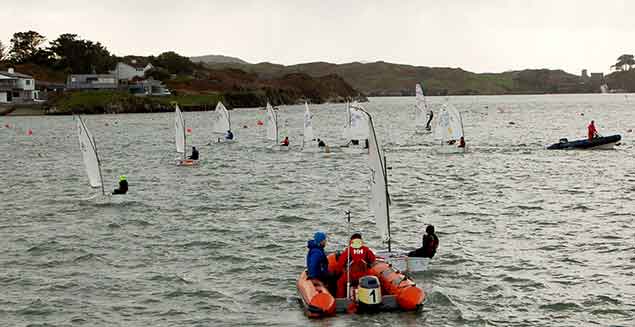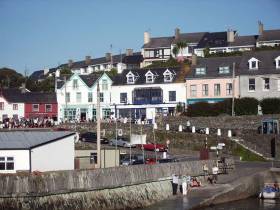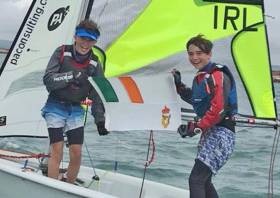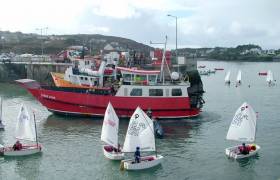Displaying items by tag: Baltimore Sailing Club
O’Leary Brothers Are Miami-Bound For Inaugural Junior Star Worlds
Baltimore Sailing Club brothers Peter and Robert O’Leary are signed up for the inaugural Junior Star Worlds in Miami’s Biscayne Bay from 3-6 February.
Last year’s bronze medallists in the Star Europeans join a list of more than 30 skipper-crew pairs under 30 already entered to compete for the first junior trophy in the storied International Star Class.
Others in the pedigree field include 2014 Star World Champion and 2017 Star Sailors League Finals winner Frithjof Kleen from Garmany, who is crewing for Italian Laser Radial world champion Guido Gallinaro.
For more see the official website for the 2019 Star Junior World Championship.
Baltimore Sailing Club Announces High Performance Fund
Baltimore Sailing Club in West Cork is now seeking expressions of interest from suitably qualified applicants for its High Performance Fund.
Details of guidelines for the Olympic Pathway support fund and the application form can be downloaded from the Baltimore Sailing Club website HERE.
The closing date for applications is Friday 21 December.
RIYC’s Norwood & Cleary Take RS Feva Southern Title In Baltimore
#RS - Thirteen Fevas battled it out with Tim Norwood and Finn Cleary of the Royal Irish Yacht Club who took their class Southern title with five bullets to count as the RS Southern Championships concluded yesterday (Sunday 16 September) in Baltimore Harbour.
Frank O’Rourke and Emma Hynes of Greystones Sailing Club had an equally impressive series, never dropping out of the top three and winning the 21-strong RS 200 fleet.
In the RS400 class, the recent third-place finishers at the RS400 Europeans held their winning form securing the Southern title in a fleet of 18 boats.
Alex Barry and Richard Leonard (Monkstown Bay/Royal Cork) held off the home team of Johnny and Harry Durcan as well as Rush Sailing Club’s Alan Ruigrok and Max McNught with five bullets.
Baltimore Sailing Club thanked event organiser Jim Griffiths, helpers afloat and onshore, the race management team, results personnel and all competitors at the late season event and a fitting conclusion to the 2018 RS calendar.
RS Southerns Results After Day One
#RS - Three races were completed yesterday (Saturday 15 September) on day one of the RS Southern Championships at Baltimore Sailing Club.
In the RS200, Frank O’Rourke and Emma Hynes on .com from Greystones Sailing Club lead the fleet with two bullets and a second place in the third race yesterday.
They stood just a point ahead of Usain Boat, helmed by Aaron Jones with Rosemary Tyrell from Greystones and the Royal Irish YC.
In the RS400, Alex Barry and Richard Leonard (Monkstown Bay/Royal Cork) were number one with three bullets, while Tim Norwood and crew Finn Cleary (RIYC) lead the RS Feva field as of yesterday evening’s results.
Baltimore Sailing Club Rings in the New Year on West Cork Coast
Baltimore Sailing Club finished off 2017 in the same manner it started - with a wave of activity writes Deirdre Horgan. December 29th saw members fill Casey’s Hotel for the Annual Dinner Dance. Commodore Michael Walsh presented the overall 1720 trophy to Boomerang (Hegarty’s) and the Heir Island Sloop overall winner was Declan Tiernan. The Best Junior Sailor for 2017 went to Joseph Griffiths. The Commodores Award was presented to Brian Leonard. Brian was praised by Michael Walsh for his planning and operation of the Sailing Courses over the past two Summers as the Senior Instructor. He also ensured the safety and enjoyment off all sailors on all levels and taster courses (which was over 300 sailors this Summer).
Commodore Michael Walsh thanked all the members, volunteers, instructors, assistants and helpers for a wonderful year. It started with the IODAI Spring Training Camp in February and the Rath National School Taster sailing course over Easter. The Summer Junior Sailing courses attracted record numbers again. Activity on the water continued throughout the Summer with Catalogue and Lousy Cup Leagues, Marconi Cup and Rambler Trophy competitions. Adult "Try sailing" courses in July and August were an excellent opportunity to get afloat or brush up on those skills under the expert eye of qualified instructions.
The season closed with the ITRA National Championships in late November. The Commodore also congratulated Fionn Lyden on his bronze medal win at the Finn U23 World Championships in Hungary. This was closely followed by his All Ireland Sailing Championship victory with crew mate Liam Manning.
Mark Hassett also continues to impress with his campaign in the 49er class and we wish them all continued success in 2018.
We wish Nicholas O'Leary of Ireland Ocean Racing every success in his Vendee Globe campaign.
Peter and Robert O’Leary are embarking on a Star campaign starting this month with events in the USA. Best of luck to them and to all our sailors competing nationally and internationally in the coming year.
The AGM was held on December 30th at noon in the Clubhouse. The newly elected Commodore Niall O’Neill thanked Michael and Sharon Walsh for all their work over the past two years. This thanks was echoed by the many members in attendance. The new committee was elected with Charlie Bolger taking over as Vice Commodore and Tom Hegarty as Sailing Secretary.
2018 Baltimore Sailing Club Junior Sailing Course Dates
JULY COURSE 2nd to 20th
TASTER COURSE July 23rd to 27th
AUGUST COURSE - 7th to 24th
Liam Manning is November’s “Sailor of the Month (Inshore)
With the year drawing to a close, it looked as though Liam Manning of Schull would be seen as 2017’s ultimate bridesmaid, as he was crew for Fionn Lyden’s All-Ireland Sailing victory in October.
But the dark days of November came up trumps for Manning – he captained the all-conquering University College Cork team to overall victory in the mid-November Intervarsities team racing in Baltimore, keeping a formidable array of talent in line.
Baltimore Sailing Club's Fionn Lyden Lying Fourth at Finn Silver Cup
Baltimore Sailing Club's Fionn Lyden is in the top five of the Finn dinghy under 23 worlds, the Finn Silver Cup, which started yesterday in Balaton in Hungary.
The move by the 2012 West Cork Laser triallist to the Tokyo 2020 mens heavyweight dinghy shows the depth of his Olympic sailing ambitions.
The talented University College Cork Engineering student counts 11, 4, and 7 to be fourthe from 45 with racing abandoned yesterday due to lack of wind.
Lyden, twice an Afloat.ie Sailor of the Month in 2012 and 2015, made history in 2015 by becoming the first helm to win all races (9) in the Irish Youth Helmsmans Championship, which then entitled him to race in the Seniors, in which he duly won the Silver Medal.
Although clearly one of the most remarkable talents to emerge in Irish sailing in recent years, he has chosen a Corinthian path. Thus most of his efforts and energy over the past few years have been dedicated to study in University College Cork but the move to the Finn is certainly an exciting development that is off to a great start in Hungary.
Despite spending four hours on the water, no more racing was possible at the U23 Finn World Championship at Balatonfüred. The sailors were twice sent out on the water, but both times came back empty handed.
Everyone expected to lose a day or more of racing, but no one expected to lose the second day, which had the second best forecast of the week.
The day began with an AP ashore, which then continued afloat for an hour before the sailors were sent back to shore to wait under a further AP. Finally they were sent back out again as a relativity stable 6-8 knots had settled over the course area. This started to drop and shift as soon as the fleet arrived and despite two attempts to get the race away, at 17.00 the fleet was sent shore again.
Results are here
Lost Boats Led To Forming Baltimore Sailing Club
Baltimore will become a centre for sailing over the next few weeks. This August weekend the annual sailing trek to the waters around Carbery’s Hundred Isles will get underway with the annual overnight race from Crosshaven to Schull. For the next few weeks the Cork sailing fraternity will be joined by boats from the East Coast, taking in events like Calves Week, Baltimore Regatta, racing around the Fastnet and the legendary Cape Clear Regatta.
The date when the club was founded varies, according to which account you take it from. A list of Commodores in the club starts in 1952 but a letter dated 3rd August 1976, written by Frank Murphy, who was the first Secretary of the club, stated that the club was founded in the summer of 1953. However, the Minutes of a Meeting held at Salters premises in Baltimore on Saturday 28th July 1956 state that "It was unanimously felt that a Sailing Club should be formed”
On my podcast this week I talk to a former Commodore of the Club, Gerald O’Flynn, who puts that date as the one when the club was formed.
Its story, set up originally as a Summer sailing club for Cork families with second homes in the fishing village, began when some of those seasonal residents lost boats in storms while they were kept at nearby Tragumna beach.
Gerald O’Flynn tells the story of boats built and bought for £75 each in ‘old’ money; about a ‘bastard-type’ of National 18, Enterprises and Fireball dinghies used by the club, the running of National Dinghy Week and the time when the club annoyed locals by covering grass areas on the pier with concrete. It’s a fascinating story about a club with a strong family emphasis which he told me in its modern premises which these days operates for a wider period than just Summer.
Listen to the PODCAST here:
• Tom MacSweeney presents THIS ISLAND NATION radio programme on local stations around Ireland.
Cork Helmsmen Take CH Marine Laser Munster Titles at Baltimore Sailing Club (Updated)
The CH Marine sponsored 2017 Laser Munster Championships attracted a strong fleet of 125 boats to Baltimore Sailing Club over the Easter Bank Holiday Weekend.
In the 45–boat Laser Radial fleet, six races were sailed with five to count.
Royal Cork's Johnny Durcan, who spent December racing Lasers in Australia, finished a two point margin over Ewan MacMahon of Howth Yacht Club on 13–points to take the title. Third was Aisling Keller of Lough Derg Yacht Club who finished on the same points tally as MacMahon.
In the standard or full rig, another south coast helmsman took the Munster title. Darragh O'Sullivan from Kinsale YC beat local ace Fionn Lyden in the 34–boat fleet. Third was Ronan Walsh of Royal Cork.
The 4.7 fleet also went to Cork with Kinsale's Michael Carroll topping the 31–boat leaderboard. Second was Howth's Daniel Hopkins and third Clare Gorman of the National Yacht Club.
Provsional results (and subject to protest) posted lasted night on the championship noticeboard are downloadable below. Afloat.ie will post any updated results as they are received.
Youth sailing continues this week for the Laser racers who compete at the ISA Youth National Championships at Ballyholme Yacht Club.
@AfloatMagazine @BaltimoreSC #baltimore #Laser #sailing 125 Boats for Munster Laser Championships in Baltimore...super day ☀️ pic.twitter.com/xK3VAGKdMa
— Peter O Flynn (@Flynner004) April 15, 2017
Baltimore Sailing Club Sets a Development Headline
I was in Baltimore Sailng Club last week for the annual training camp run by the Optimist Association when 130 young sailors braved and overcame what were at times quite testing sailing conditions. I watched with admiration the impressive organisation of the event and the readiness of the youngsters to venture out on the waters of the bay when, I should honestly say, I would not have been over-anxious to do so myself. The Optimist Association is well-organised and they were at a club which is directing a lot of its efforts towards encouraging young sailors.
Baltimore Sailing Club undertook a major refurbishing and upgrading of its premises on the quayside in 2013 and also reinvigorated the organisational structure of the club which had been founded in 1956 as a Summer sailing club. This is the seasonal time when the population of the historic West Cork village is increased considerably by the influx of holidaymakers from Cork and further around the coast.
This weekend the Baltimore Laser Icicle Regatta is scheduled, deferred from the Christmas holiday period by bad weather. That will be followed at Easter when the club intends to introduce the RS200 to the classes which sail there.
 Optimist dinghy training at Baltimore, West Cork
Optimist dinghy training at Baltimore, West Cork
Baltimore is setting a strong headline in the development of sailing.
Listen to the Podcast from my visit to Baltimore below and interviews with Michael Walsh, Club Commodore and Sheila O’Sullivan, Junior Sailing Organiser.







































































